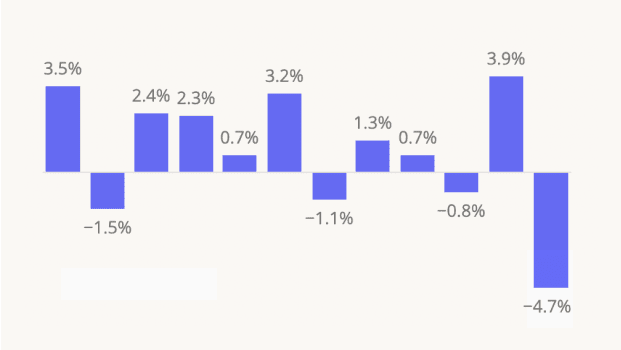Dollar Tree's recently announced plan to sell Family Dollar at a significant loss is another sign of the recent struggles in the discount and dollar store sector, highlighted by last year’s closure of 99 Cents Only and Big Lots' bankruptcy filing. We dove into the data to understand what is driving Dollar Tree’s decision and what this means for Family Dollar moving forward.
Growth Decelerating for Wider Discount & Dollar Store Category
The discount & dollar store category had been on the rise before the pandemic, and COVID gave the segment another considerable boost – in part thanks to discount and dollar stores’ designation as “essential retailers” that could remain open during lockdowns. Category leaders Dollar General and Dollar Tree continued their aggressive fleet expansions to meet the growing consumer demand, which led to a substantial overall increase in visits to the category.
But zooming in on 2024 data suggests that visit growth to the category is slowing down. Although discount & dollar stores are holding on to their pandemic gains – traffic to the segment is still 57.8% higher than it was in 2017 – year-over-year (YoY) growth is slowing, with 2024 visits up 2.8% compared to 2023, in contrast to 2022 and 2023’s YoY jumps of 7.8% and 7.7%, respectively.
This deceleration of growth is not in itself worrisome – no retail category can sustain rapid growth indefinitely. But the visit trends do signal that discount & dollar store leaders seeking an edge over the competition will need to adopt more strategic approaches and avoid allocating resources to overly risky ventures.
Dollar Tree Thrived While Family Dollar Lagged Behind
Overall visits to the Dollar Tree brand were already on the rise prior to COVID and skyrocketed over the pandemic – leading to a 60.1% increase in overall visits between 2017 and 2024. But, like with the wider category, traffic growth to Dollar Tree seems to be decelerating – the banner posted a 5.4% YoY increase in visits in 2024 compared to a 13.9% YoY increase in 2023.
But Family Dollar lagged behind, apparently immune to the COVID-driven dollar store visit surge. Traffic to the chain in 2024 was down 4.0% YoY and just 3.6% higher than it was in 2017. And although Dollar Tree’s decision to close nearly 1000 Family Dollar stores appears to be bearing fruit – in 2024, average visits per venue were up 1.7% YoY and 16.9% relative to the 2017 baseline – the improvement seems to have been insufficient to prevent the banner’s sale.
What Hampered Family Dollar’s Growth?
Family Dollar has faced plenty of difficulties in the last several years, so it’s difficult to attribute Dollar Tree’s offloading of the banner to a single factor. Still, one major element that likely hurt the brand’s performance was the intensified competition from other discount and dollar store leaders – including from sister banner Dollar Tree.
Family Dollar visitors have always been keen Walmart shoppers – since 2019, over 90% of Family Dollar yearly visitors also visited Walmart, and these cross-visit trends have remained relatively stable over the past six years. Other dollar stores were not always as popular with Family Dollar shoppers – in 2019, less than two-thirds of Family Dollar visitors also visited a Dollar Tree or a Dollar General. But as those chains grew, so did their appeal to Family Dollar shoppers – by 2024, over three-quarters of Family Dollar visitors also visited Dollar Tree or Dollar General – and this increased competition likely hampered Family Dollar’s growth.
Family Dollar Can Fill a Unique Niche in the Dollar Store Space
Still, despite the increasingly competitive discount and dollar store space, analyzing Family Dollar’s trade area composition reveals that the chain fills a unique niche within the broader discount retail sector.
Family Dollar tends to attract the least affluent visitor base – the median household income (HHI) in the chain’s captured market trade area is $53.9K, compared to $67.6K, $61.8K, and $68.7K for Walmart, Dollar General, and Dollar Tree, respectively. Family Dollar’s captured market also includes the highest share of urban areas, with 36.9% of its trade area defined as “Urban Periphery” or “Principal Urban Center” by the Esri: Tapestry Segmentation database.
Family Dollar can draw on its distinctive position as an urban-based retailer catering to value-seeking consumers to set itself apart from the competition and lay the groundwork for a successful resurgence.
Family Dollar’s Path to a Comeback
Although Family Dollar was sold at a substantial discount from its original purchase price, the chain still has a promising opportunity to re-establish itself as a powerful contender in the discount retail landscape. By prioritizing locations in urban areas that are less exposed to direct competition from the other major players and keeping its prices competitive with those of other dollar and discount retailers, Family Dollar can lay the groundwork for a successful resurgence.
For more data-driven retail insights, visit placer.ai




.png)
.png)

.png)
.png)














.svg)